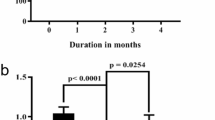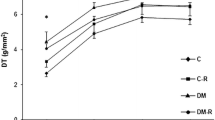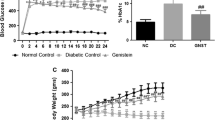Abstract
Earlier we reported that probucol treatment subsequent to the induction of diabetes can prevent diabetes-associated changes in myocardial antioxidants as well as function at 8 weeks. In this study, we examined the efficacy of probucol in the reversal of diabetes induced myocardial changes. Rats were made diabetic with a single injection of streptozotocin (65 mg/kg, i.v.). After 4 weeks of induction of diabetes, a group of animals was treated on alternate days with probucol (10 mg/kg i.p.), a known lipid lowering agent with antioxidant properties. At 8 weeks, there was a significant drop in the left ventricle (LVSP) and aortic systolic pressures (ASP) in the diabetic group. Hearts from these animals showed an increase in the thiobarbituric acid reacting substances (TBARS), indicating increased lipid peroxidation. This was accompanied by a decrease in the myocardial antioxidant enzymes activities, superoxide dismutase (SOD) and glutathione peroxidase (GSHPx). Myocardial catalase activity in the diabetic group was higher. In the diabetic + probucol group both LVSP and ASP showed significant recovery. This was also accompanied by an improvement in SOD and GSHPx activities and there was further increase in the catalase activity. Levels of the TBARS were decreased in this group. These data provide evidence that diabetic cardiomyopathy is associated with an antioxidant deficit which can be reversed with probucol treatment. Improved cardiac function with probucol may be due to the recovery of antioxidants in the heart.
Similar content being viewed by others
References
Kannel WB: Role of diabetes in cardiac disease. In: S. Zoneraich, (ed.) Diabetes and the Heart, Charles C. Thomas, Springfield, Illinois pp 97–120
Rubler S, Dlugash J, Yuceoglu UZ, Kumral T, Branwood AW, Grishman A: New type of cardiomyopathy associated with diabetic glomerulosclerosis. Am J Cardiol 30: 595–602, 1972
Regan TJ, Lyons MM, Ahmed S, Levinson GE, Oldewurtel HA, Ahman M, Haider B: Evidence for cardiomyopathy in familial diabetes mellitus. J Clin Invest 60: 885–893, 1977
Dhalla NS, Pierce GN, Innes IR, Beamish RE: Pathogenesis of cardiac dysfunction in diabetes mellitus. Can J Cardiol 1: 263–284, 1985
Fein FS, Sonnenblick EH: Diabetic cardiomyopathy. Prog Cardiovasc Dis H 27: 255–270, 1985
Wohaieb SA, Godin DV: Alterations in free radical tissue defense mechanisms in streptozotocin induced diabetes in the rat: Effects of insulin treatment. Diabetes 36: 1014–1018, 1987
Kaul N, Siveski-Iliskovic N, Thomas TP, Hill M, Khaper N, Singal PK: Probucol improves antioxidant activity and modulates development of diabetic cardiomyopathy. Nutrition. In Press, 1995
Simmons KJ Defence against free radicals has therapeutic implications. J Amer Med Assoc 251: 2187–2192, 1984
Halliwell G, Gutteridge JMC: Lipid peroxidation, oxygen radicals, cell damage and antioxidant therapy. Lancet 1: 1396–1397, 1984
Kaul N, Siveski-Iliskovic N, Hill M, Slezak J, Singal PK: Free radicals in the heart. J Pharmacol Toxicol Meth 30: 55–63, 1993
Parthasarathy S, Young SG, Witztum TL, Pittman RC, Steinberg D: Probucol inhibits oxidative modification of low density lipoproteins. J Clin Invest 77: 641–644, 1986
Carew TE, Schwenke DC, Steinberg D: Antiatherogenic effect of Probucol unrelated to its hypocholesterolemic effect. Proc Natl Acad Sci, USA 84: 7725–7729, 1984
Siveski-Iliskovic N, Kaul N, Singal PK: Probucol promotes endogenous antioxidants and provides protection against adriamycin-induced cardiomyopathy. Circulation. 89: 2829–2835, 1994
Siveski-Iliskovic N, Hill M, Chow D, Singal PK: Probucol protects against adriamycin cardiomyopathy without interfering with its antitumor effect. Circulation 91: 10–15, 1995
Chisolm GM, Morel DW: Lipoprotein oxidation and cytotoxicity: Effect of probucol on streptozotocin treated rats. Am J Cardiol 62: 20B-26B, 1988
Morel DW, Chisolm GM: Antioxidant treatment of diabetic rats inhibits lipoprotein oxidation and cytotoxicity. J Lipid Res 30: 1827–1834, 1989
Matsushita M, Yoshino G, Iwai M: Protective effects of probucol on alloxan diabetes in rats. Diabetes Res Clin Prac 7: 313–316, 1989
Bondar RJL, Mead DC: Evaluation of glucose-6-phosphate dehydrogenase from leuconostoc mesenterioles in the hexokinase method for determining glucose in serum. Clin Chem 20: 586–590, 1974
Marklund SL: Pyrogallol autoxidation. In: R.A. Greenwald, (ed.) Handbook of Methods for Oxygen Radical Research. Boca Raton, Florida: CRC Press, 1985 pp 243–247
Paglia DE, Valentine WN: Studies on the quantitative and qualitative characterization of erythrocyte glutathione peroxidase. J Lab Clin Med 70: 158–247, 1967
Clairborne A: Catalase activity. In: R.A. Greenwald (ed.) Handbook of Methods for Oxygen Radical Research. Boca Raton, Florida: CRC Press, 1979 pp 283–284
Placer ZA, Cushman LL, Johnson BC: Estimation of product of lipid peroxidation (malondialdehyde) in biochemical systems. Anal Biochem 16: 359–365, 1966
Aust SD: Lipid peroxidation. In: R.A. Greenwald (ed.) Handbook of Methods for Oxygen Radical. Boca Raton, Florida: CRC Press, 1985 pp 203–207
Lowry OH, Rosebrough NJ, Farr AL, Randall AJ: Protein measurement with the folin phenol regent. J Biol Chem 193: 265–275, 1951
Regan TJ, Ettinger PO, Khan ME, Jesuani MU, Lyon MM, Oldewurtel HA, Weber M: Altered myocardial function and metabolism in chronic diabetes mellitus without ischemia in dogs. Circ Res 35: 222–237, 1974
Factor SM, Minase T, Sonnenblick E: Clinical and morphological features of human hypertensive diabetic cardiomyopathy. Am Heart J 99: 446–458, 1980
Heyliger CE, Pierce GN, Singal PK, Beamish RE, Dhalla NS: Cardiac alpha and beta adrenergic receptor alterations in diabetic cardiomyopathy. Basic Res Cardiol 77: 610–618, 1982
Pierce GN, Dhalla NS: Mechanism of defect in cardiac myofibrillar function during diabetes. Am J Physiol 248: E170-E175, 1985
Pierce GN, Kutryk MJB, Dhalla NS: Alterations in Ca2+ binding by and composition of the cardiac sarcolemmal membrane in chronic diabetes. Proc Natl J Acad Sci, USA 80: 5412–5416, 1983
Makino N, Dhalla KS, Elimban V, Dhalla NS: Sarcolemmal calcium transport in streptozotocin-induced diabetic cardiomyopathy in rats. Am J Physiol 253: E202-E207, 1983
Penparkgul S, Fein F, Sonnenblick Eh, Scheuer J: Depressed cardiac sarcoplasmic reticular function from diabetic rats. J Mol Cell Cardiol 13: 303–309, 1981
Ganguly PK, Pierce GN, Dhalla KS, Dhalla NS: Defective sarcoplasmic reticulum calcium transport in diabetic cardiomyopathy. Am J Physiol 244: E528-E535, 1983
Kobayashi A, Yamashete T, Kaneko M, Nishiyama T, Hayashi H, Yamazaki N: Effects of verapamil on experimental cardiomyopathy in the Syrian hamster. JACC 10: 1128–1134, 1987
Gupta M, Singal PK: Time course of structure, function, and metabolic changes due to an exogenous source of oxygen metabolites in rat heart. Can J Physiol Pharmacol 67: 1549–1559, 1989
Guarnieri C, Flamigni F, Caldarera CM: Role of oxygen in cellular damage induced by reoxygenation of hypoxic heart. J Mol Cell Cardiol 12: 797–808, 1980
Hodgson EK, Fridovich I: The interaction of bovine erythrocyte superoxide dismutase with hydrogen peroxide: Chemiluminescence and peroxidation. Biochemistry 14: 5399–5303, 1975
Searle AJ, Willson RL: Glutathione peroxide: Effect of superoxide, hydroxyl and bromine free radicals on enzyme activity. Int J Radiat Biol 37: 213–217, 1980
Giuliano D, Acampara R, D'Onofrio P: Medical hypothesis: cardiovascular complications of diabetes mellitus-from glucose to insulin and back. Diabetic Metabol 20: 445–453, 1994
Marshall RN: Pharmacology and toxicology of probucol. Artery 10: 7–21, 1982
Drash AL, Rudert WA, Borquaye S, Wang R, Lieberman I: Effect of probucol on development of diabetes mellitus in BB rats. Am J Cardiol 62: 27B-30B, 1988
O'Brien K, Nagano Y, Gown A, Kita T, Chait A: Probucol treatment affects the cellular composition but not antioxidized low density lipoprotein immunoreactivity of plaque from Watanabe heritable hyperlipedimic rabbits. Arteriosclerosis and Thrombosis 11: 751–759, 1991
Litwin SE, Raya TE, Anderson PG, Daugherty S, Goldman S: Abnormal cardiac function in the streptozotocin-diabetic rat. J Clin Invest 86: 481–488, 1990
Schwartz CJ: Introduction — The Probucol Experience: A review of the past and a look at the future. Am J Cardiol 62: 1B-5B, 1988
Author information
Authors and Affiliations
Rights and permissions
About this article
Cite this article
Kaul, N., Siveski-Iliskovic, N., Hill, M. et al. Probucol treatment reverses antioxidant and functional deficit in diabetic cardiomyopathy. Mol Cell Biochem 160, 283–288 (1996). https://doi.org/10.1007/BF00240060
Issue Date:
DOI: https://doi.org/10.1007/BF00240060




